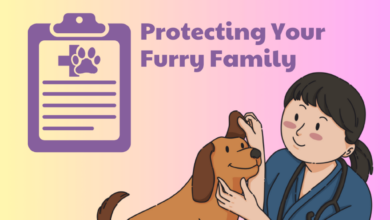Protecting Your Furry Friends: Affordable Health Insurance for Pets
In today’s world, our furry companions hold a special place in our hearts and homes. As responsible pet owners, we want to ensure their well-being every step of the way, including providing them with adequate healthcare. However, the rising costs of veterinary care can pose a financial challenge for many of us. Fortunately, affordable pet insurance options have emerged to help us navigate the expenses associated with keeping our pets healthy and happy. This article explores the benefits of affordable health insurance for pets, providing pet owners with peace of mind and ensuring access to essential veterinary services without breaking the bank.
Contents
- 1 1. Types of Pet Insurance Plans
- 2 2. Factors Affecting Pet Insurance Premiums
- 3 3. Comparing Pet Insurance Policies
- 4 4. Choosing the Right Pet Insurance Plan
- 5 5. Enrolling Your Pet in a Plan
- 6 6. Filing a Pet Insurance Claim
- 7 7. Tips for Saving Money on Pet Insurance
- 8 8. Understanding Pet Insurance Exclusions
- 9 9. Finding Affordable Pet Insurance Options
- 10 10. The Importance of Pet Health and Insurance
- 11 Choosing the Right Plan for Your Pet:
- 12 Factors Affecting Pet Insurance Costs
- 13 Comparing Pet Insurance Costs
- 14 Thanks for Pawing Around!
1. Types of Pet Insurance Plans
Understanding the different types of pet insurance plans available is crucial for finding the best coverage for your furry friend. Here are the most common options:
* Accident-Only Plans: These plans provide coverage for unexpected accidents, such as broken bones or lacerations. They are a less comprehensive option but offer a lower premium.
* Illness-Only Plans: As the name suggests, these plans cover illnesses such as cancer, diabetes, or urinary tract infections. They exclude accidents from coverage.
* Comprehensive Plans: Comprehensive plans provide the most comprehensive coverage, including both accidents and illnesses. While they typically have higher premiums, they offer peace of mind and financial protection for unexpected medical expenses.
* Wellness Plans: These plans cover routine care such as vaccinations, spaying/neutering, and dental cleanings. They are not insurance plans but rather a form of preventative care coverage.
2. Factors Affecting Pet Insurance Premiums
Several factors influence the cost of pet insurance premiums, including:
* Species and Breed: Different species and breeds of pets have varying health risks, which can affect premiums.
* Age: Older pets are generally more expensive to insure due to higher healthcare costs.
* Location: Premiums can vary depending on the geographic location, as veterinary costs can differ across regions.
* Deductible: The deductible is the amount you pay out of pocket before insurance coverage kicks in. Higher deductibles result in lower premiums.
* Coverage Limits: The coverage limits determine the maximum amount the insurance plan will pay for veterinary expenses. Higher coverage limits come with higher premiums.
3. Comparing Pet Insurance Policies
When comparing pet insurance policies, it’s essential to carefully review the details of each plan. Consider factors such as coverage, premiums, deductibles, and exclusions. It’s also important to read customer reviews and research the reputation of the insurance provider.
4. Choosing the Right Pet Insurance Plan
Choosing the right pet insurance plan requires balancing your budget, your pet’s health needs, and the level of coverage you desire. Consider your pet’s age, breed, and any pre-existing conditions when making a decision.
5. Enrolling Your Pet in a Plan
Once you’ve selected a pet insurance plan, you can enroll your furry friend. Most insurance providers require you to provide your pet’s medical records, as well as information about their age and breed.
6. Filing a Pet Insurance Claim
If your pet experiences a medical issue covered by your insurance policy, you can file a claim. Be sure to keep all receipts and documentation related to the expenses. The insurance provider will review your claim and determine the amount of coverage you’re entitled to.
7. Tips for Saving Money on Pet Insurance
There are several ways to reduce the cost of pet insurance, including:
* Choose a Higher Deductible: Opting for a plan with a higher deductible will lower your monthly premiums.
* Bundle Insurance Policies: Some providers offer discounts for bundling pet insurance with homeowner’s or renter’s insurance.
* Look for Employee Benefits: Check if your workplace offers pet insurance as an employee benefit.
8. Understanding Pet Insurance Exclusions
Every pet insurance policy has exclusions, which are conditions or treatments not covered. Common exclusions include pre-existing conditions, elective surgeries, and grooming expenses.
9. Finding Affordable Pet Insurance Options
For those on a budget, there are several affordable pet insurance options available:
* Low-Cost Plans: Basic plans with limited coverage can provide a more affordable option.
* Group Policies: Joining group pet insurance policies through organizations or employers can offer reduced premiums.
* Non-Profit Insurers: Non-profit pet insurance providers may offer lower premiums and flexible payment plans.
10. The Importance of Pet Health and Insurance
Pet insurance is an essential investment in your furry companion’s well-being. It provides financial protection against unexpected veterinary expenses and gives you peace of mind knowing that your pet will receive the best possible care. By understanding the different types of plans available and carefully comparing policies, you can find an affordable pet insurance solution that meets the needs of your pet and your budget.
Choosing the Right Plan for Your Pet:
1. Coverage Types:
- Accident-Only Plans: Focus on injuries and emergencies, with limited coverage for other expenses.
- Wellness Plans: Cover routine care and preventive services, such as vaccinations and exams.
- Comprehensive Plans: Combine accident and wellness coverage, providing the most extensive protection.
2. Deductibles and Coinsurance:
- Deductible: The amount you pay before insurance starts covering expenses.
- Coinsurance: The percentage of covered expenses you’re responsible for after the deductible is met.
3. Annual Coverage Limits:
- Set a maximum amount that the insurer will cover per year, ensuring your pet has adequate financial protection.
4. Waiting Periods:
- Indicates the time you must wait before coverage takes effect for certain conditions.
5. Pre-Existing Conditions:
- Most plans exclude coverage for pre-existing conditions, meaning conditions that existed before the policy was purchased.
6. Breed Exclusions:
- Certain breeds may be excluded from coverage due to potential health risks or pre-existing conditions.
7. Riders and Add-Ons:
- Optional coverage options that can enhance your plan, such as dental care or behavioral therapy.
8. Cancellation Policies:
- Understand the options for canceling or modifying your policy, including any potential fees.
9. Reputation and Customer Service:
- Research the insurer’s reputation, customer reviews, and online support availability.
10. Premiums:
- Compare premiums from different providers to find the most affordable option that meets your needs.
Factors Affecting Pet Insurance Costs
The cost of pet insurance can vary significantly depending on several factors, including:
Age
Younger pets are typically less expensive to insure than older pets because they have a lower risk of developing health problems. As pets age, their premiums may increase due to the increased likelihood of illness and accidents.
Breed
Some breeds are more prone to certain health conditions than others, which can impact insurance costs. For example, breeds with a higher risk of genetic disorders may have higher premiums.
Location
The cost of pet insurance can vary depending on your location. Areas with higher veterinary costs may have higher insurance premiums.
Deductible
The deductible is the amount you pay out-of-pocket before your insurance coverage kicks in. Higher deductibles typically result in lower premiums, while lower deductibles lead to higher premiums.
Coverage Level
The level of coverage you choose will also affect the cost of pet insurance. Policies with more comprehensive coverage, such as those that cover accidents, illnesses, and wellness care, will typically have higher premiums than policies with more limited coverage.
Comparing Pet Insurance Costs
To find the most affordable pet insurance for your furry friend, it’s essential to compare quotes from multiple insurance providers. Here’s a table to help you compare costs:
| Insurance Provider | Monthly Premium | Deductible | Coverage |
|---|---|---|---|
| Company A | $50 | $250 | Accident and illness |
| Company B | $65 | $100 | Accident, illness, and wellness care |
| Company C | $40 | $500 | Accident and illness |
| Company D | $75 | $200 | Accident, illness, and dental care |
| Company E | $35 | $300 | Accident and illness |
Thanks for Pawing Around!
Well, there you have it, folks! Pet insurance doesn’t have to be a pawful. With these options available, you can keep your furry friend happy and healthy without breaking the bank. Remember, it’s always better to be pawpared when it comes to your pet’s health. So, browse through our other pet-related articles and make sure to visit us again for more tail-wagging insights. Thanks for reading, and may your pet’s health insurance adventures be as pawsome as possible!








